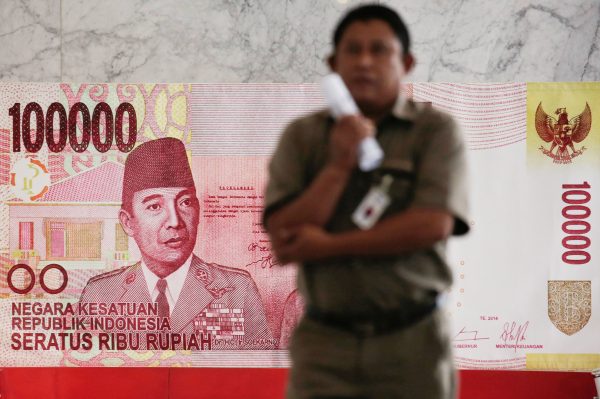But the first phase of the tax amnesty program from July–September 2016 ended with a total redemption of around 97 trillion rupiah (US$7 billion) — more than half of the total target. Given there are two more phases (October–December 2016 and January–March 2017), the program’s target is looking increasingly realistic.
Several factors might explain this achievement. First, the return of Sri Mulyani as the Minister of Finance seems to have helped restore public confidence in the ministry. Notwithstanding her measured and careful take on the tax amnesty policy, Mulyani was personally determined to ensure the program’s success. She was actively involved in promoting it to the public, even to those who have assets in Singapore. At the same time, Mulyani toned down state budget expectations through a more credible budget posture for 2017.
Second, the tax amnesty program received high-level and widespread support. Indonesian President Joko Widodo himself took part in a series of public events asking the Indonesian people to report their undeclared assets and repatriate those stashed abroad. The House of Representatives gave similar support, albeit after some disagreement prior to passing the bill. The media also constantly reported the campaign. This included publishing pictures of business tycoons declaring their assets to set an example for other business people — although these pictures also showcased taxpayers who had previously avoided paying their dues.
But there are also some caveats to this success. First, efforts to repatriate Indonesian assets abroad have been lacklustre. By the second week of December, 988 trillion rupiah (approximately US$75 billion) of assets overseas (mostly in Singapore) had been declared but only 144 trillion rupiah (less than 15 per cent) were repatriated. This is a far cry from the target of 1 quadrillion rupiah (approximately US$75 trillion).
Second, another objective of the tax amnesty is to widen the tax base. Some 20,000 new taxpayers have registered since the tax amnesty was first rolled out. This is good news, but compared to the number of Indonesians who are supposed to pay tax, this number is trivial.
Third, there is no easy way to predict whether the second and third phases of the program will equal the successes of the first phase. The majority of the first round of payments came in only in the last two weeks — about 80 out of the 97 trillion rupiah. While it is possible that another big bulk will come through in the last week of December, the redemption rate will have increased by then. This will either put off those who are willing to declare their assets or means that they have already done it in the first phase to take advantage of the lower rates.
If this is true, the last phase in 2017 might see even lower results, as the redemption rate for repatriated assets will increase to 5 per cent (from 2 per cent in the initial phase) and the declaration without repatriation rate will increase from 4 per cent to 10 per cent.
Finally, Indonesia’s tax amnesty program was initiated in an attempt to help raise revenue amidst the predicted shortfall in tax collection. But it is by no means sufficient to solve Indonesia’s fiscal challenges. It should instead be a small part of a larger tax reform package. Other necessary steps include simplifying tax regulations that currently leave little room for discretion and reducing compliance costs. Other exemptions that erode the tax base should also be reduced.
The tax amnesty program is not a sustainable long-term policy. The current redemption rates, which will increase to 10 per cent in 2017, are far too lenient compared to the official tax rates that reach 30 per cent. This implies just how weak the government’s bargaining position is — arguably due to the fact that the government doesn’t know exactly who dodges taxes. Otherwise, it could have imposed penalty rates even higher than official tax rates.
In 2018 Indonesia is set to implement the Automatic Exchange of Information framework that will allow the government to have greater access to the financial assets of Indonesian citizens invested or stored abroad. If that framework is effective the government can afford to be less lenient on tax dodgers.
Arianto Patunru is a fellow at the Arndt-Corden Department of Economics and policy engagement coordinator at the Indonesia Project, Crawford School of Public Policy, The Australian National University.


A good summary of steps towards a better tax system.
Terima kasih, Pak Arianto
Thanks, Pak Andrew!
Jokowi may see the recent rise in anti-Chinese sentiment in Indonesia generated by, or at least accompanying, the Ahok blasphemy affair as an obstacle to the further repatriation of wealth held by Indonesian-Chinese in Singapore.
Why send back money to Indonesia in an atmosphere where the TNI commander, for example, makes a habit of condemning China’s alleged designs on Indonesia and claims that China is trying to weaken Indonesian society by exporting narcotics on a large scale?
Jokowi has been particularly vexed by stories that millions of Chinese are working illegally in Indonesia. He admits to hoping that ten million Chinese tourists will come to Indonesia, rather than working there, but even this may be an unwise and provocative goal in the current environment.
The appropriately-named website, media.pribumi.com, conveys the full range of fantasies about China and the Chinese.
Thanks, Ken! You’ve raised a good point.